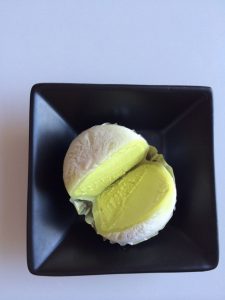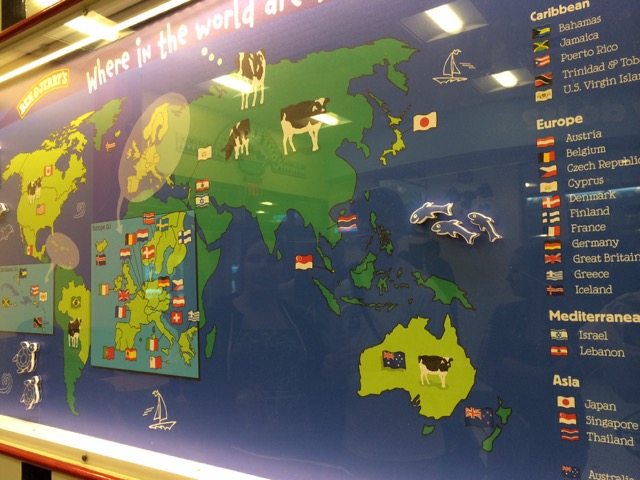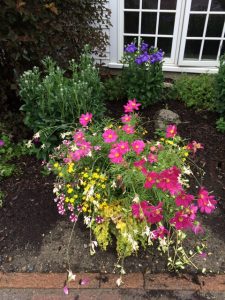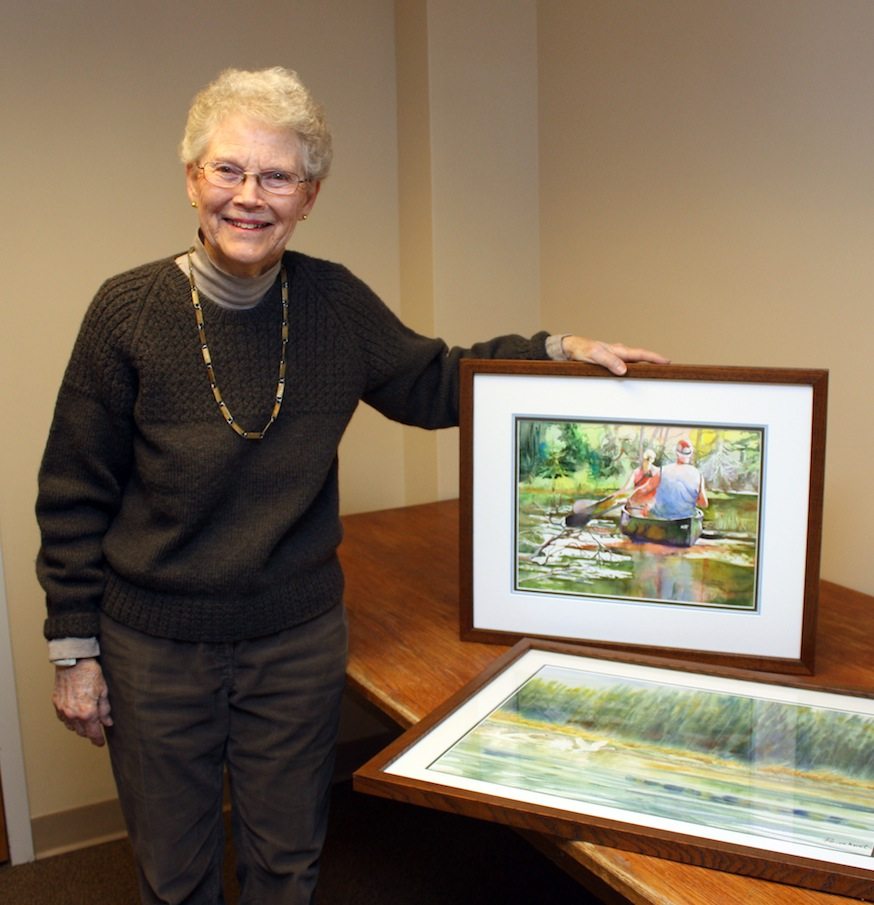Archive for the ‘Vermont’ Category
Ice Cream
I know I shouldn’t admit this, but I love ice cream. Not exactly your top health food, but at least it does contain calcium. I rarely eat it at home, and reward myself when I travel, with a scoop of the local specialties. In Italy, there is gelato; in France crème glacée – each with very different textures and flavors than American ice cream.  I first tasted green tea ice cream at a street vendor’s cart in Shizuoka, Japan, and have since had it at pretty much any sushi restaurant that serves it. I always thought that “mochi” ice cream – a sweet confection of ice cream wrapped in pounded sticky rice, was also a Japanese specialty, but it turns out it was invented by a Japanese American, Frances Hashimoto, right in L.A.’s Little Tokyo, where I first tasted it – of course, filled with green tea ice cream.
I first tasted green tea ice cream at a street vendor’s cart in Shizuoka, Japan, and have since had it at pretty much any sushi restaurant that serves it. I always thought that “mochi” ice cream – a sweet confection of ice cream wrapped in pounded sticky rice, was also a Japanese specialty, but it turns out it was invented by a Japanese American, Frances Hashimoto, right in L.A.’s Little Tokyo, where I first tasted it – of course, filled with green tea ice cream.
As a child, my favorite flavors were vanilla, orange, and banana. It was a thrill to hand over our coins in exchange for a sugar cone, when my sister and best friend and I were first allowed to walk, alone, the five blocks to our local ice cream parlor in Montreal. On a recent trip back, I visited the place. Its name is changed and, like the whole area, it is much gentrified, with sidewalk tables and flavors like “Lavande et Miel” (Lavender and Honey) – divine, but not my simpler childhood memories.
In Burlington, Vermont they call soft ice cream “cremees,” and it is impossible to be in that state without tasting maple cremees in each locale, and comparing them – the equivalent of a pub crawl for beer, but in this case an ‘ice cream crawl.’
And then there is Ben and Jerry’s. Shockingly there is no plaque commemorating the site of a former gas station in downtown Burlington, where the boys first started scooping their product. It is just an empty lot. However, on Church Street, Burlington’s walking promenade, a second street sign sits atop the one for Cherry Street, on the corner of which the Ben and Jerry’s shop is situated. It reads “Cherry Garcia.”
This year, when we visited the Ben and Jerry’s Factory in Waterbury, Vermont, on a July weekend, the place was crowded with families with young children, teenagers, and older adults of many nationalities all waiting for their tours. In summer these are spaced every ten minutes, from 9am through to 9pm closing. I could hear many languages besides American, Brit, and Australian English, including French, Chinese, and German. This and the world map in the entrance lobby showing all the locations where Ben and Jerry’s ice cream is sold, fit with my having had a cup of the stuff at Australia’s Sydney Opera House, and seeing it in a vending machine at Heathrow Airport in London.
What is it about ice cream that speaks to so many people around the world, young and old and everything in between?
I posed this question to Jerry Greenfield when we met at a wedding last year in Burlington, Vermont. The bride’s mother was a long-time friend of Jerry’s and Ben Cohen, and had helped them out at the shop almost from its inception, even naming and perfecting some flavors. Jerry’s wedding gift to the young couple: he and his son were on hand to scoop the ice cream he had provided for the guests. The bride and groom were from Vienna, and their many Austrian friends were thrilled at the chance to take selfies while being handed scoops from Jerry himself. And truth be told, so was I.
I shared with him my personal ritual when I lived in Washington, DC, of eating a chocolate-coated Cherry Garcia while walking under the arching cherry trees in full bloom. It was often cold at that time of year, but the experience always boosted my spirits.
We talked about how smell and taste are the most ancient and direct routes to the brain’s emotional and memory centers, triggering release of pleasure chemicals in the brain’s reward centers. Jerry’s wife, a psychologist, and I continued the conversation after he and his son had to leave to tend to the ice cream for the wedding reception. It seems there is a rather narrow temperature window between frozen too hard and soupy melted, when the flavor and texture of ice cream is just right. The science of ice cream creation clearly involves both chemistry and sensory neuroscience.
Water
During a recent interview, Tucson radio show host, Rabbi Cohon asked me what it is about water that is so healing (listen to PART 1, PART 2). Water seemed to him to be a common feature of many of the more than one hundred and forty sacred healing sites around the world, which he had visited the previous year.There is no question that water – seeing it, smelling it, hearing it, being in it, can calm and help heal. Perhaps ancient peoples recognized the hygienic effects of water. Swimming and bathing in warm waters helps aching joints, and the exercise is of course healthy.
 As I sit on a boat on Lake Champlain in Northern Vermont, I can smell the earthy fragrance of the lake and hear the lapping of the gentle waves upon the hull. Why did this give me a sense of calm?
As I sit on a boat on Lake Champlain in Northern Vermont, I can smell the earthy fragrance of the lake and hear the lapping of the gentle waves upon the hull. Why did this give me a sense of calm?
Perhaps it was because it reminded me of many summers visiting my sister and brother-in-law at their “camp” on Methuen Pond outside of Boston. That brought my thoughts to those times as a medical student when I would take a tiny Sunfish sailboat out on the Charles River that separates Boston from Cambridge, Massachusetts. Digging deeper into my memory, I remembered the summers when my sister and I used to visit our best friend’s family cottage at Lac Nominingue – one hundred and twenty-five miles north of Montreal, or when we would visit my aunt and uncle and cousins at their rented cottage on Trout Lake, only sixty miles north of Montreal.
I remembered swimming in the bracing water and running back to the house shivering, in Nominingue to stand in front of the warm fireplace; at Trout Lake to have a lunch of macaroni and cheese, which my aunt had at the ready for us teeth-chattering children. With our parents we sometimes would drive south from Montreal to Vermont, New Hampshire, or Upstate New York, and stay in little pine paneled cottages next to running brooks, where we would step from stone to stone. So, water for me was all these memories rolled into one – memories of vacation, family, friends, and love.
 Now, since moving to Tucson, Arizona in 2012, I spend summers with my partner, telecommuting from Vermont. On weekends, from our boat on Lake Champlain, I look out over the ever-changing water towards the hills and mountains – Vermont’s Green Mountains, and New York’s Adirondacks. It is a meditation.
Now, since moving to Tucson, Arizona in 2012, I spend summers with my partner, telecommuting from Vermont. On weekends, from our boat on Lake Champlain, I look out over the ever-changing water towards the hills and mountains – Vermont’s Green Mountains, and New York’s Adirondacks. It is a meditation.
 When floating on six trillion gallons of water – Lake Champlain is the “sixth Great Lake” – it is hard to imagine that there are places on earth where there is none. In Tucson, I have become acutely aware of lack of water, and carefully monitor my use of it. We rejoice when the Rillito River, most of the year a dry riverbed, occasionally fills with water after a storm. People line up to photograph the roiling waters charging past.
When floating on six trillion gallons of water – Lake Champlain is the “sixth Great Lake” – it is hard to imagine that there are places on earth where there is none. In Tucson, I have become acutely aware of lack of water, and carefully monitor my use of it. We rejoice when the Rillito River, most of the year a dry riverbed, occasionally fills with water after a storm. People line up to photograph the roiling waters charging past.
When the monsoon rains come to Tucson in summer, or the quieter steady rains in early spring, the desert bursts into bloom – subtle by Vermont standards, but dramatic against the backdrop of rocks and scrub. When it rains all day or all night in Vermont, I appreciate all the more the greenery that follows and the profusion of wildflowers in the roadside and fields.
While the desert holds many charms, how awful it would be without water all the time. The contrast makes me all the more conscious of how important it is to preserve this most precious of all our commodities.
Lasting Art, Part 3: The Work Continues
A few days after I returned to Burlington, Vermont from the Susan Sebastian event at the Southern Vermont Art Center (Part 1, Part 2), I sat down for coffee with Gil Myers, a retired attorney who had set up and now manages the Foundation. He had been a longtime friend of Susan Sebastian’s mother, Elise Braun. He had suggested we meet at a coffee house across from the Court House in downtown Burlington. A small man with white hair and twinkly eyes, he carried a gnarled wooden country walking stick, much like Gandalf or Sam Gamgee might have done in Lord of the Rings.  Self effacing and humble, he downplays his central role in carrying through Susan Sebastian’s dying wish, to install original art in every patient room in every hospital in Vermont. At first Elise Braun was the moving force, he recounted, but after they had completed placing art in three hospitals, Elise fell ill and Myers was the one who carried the project through to its completion. Nonetheless, he insisted throughout that it was not his but Elise’s achievement – he was simply the instrument who completed the task. As he told me – “that’s what lawyers do.”
Self effacing and humble, he downplays his central role in carrying through Susan Sebastian’s dying wish, to install original art in every patient room in every hospital in Vermont. At first Elise Braun was the moving force, he recounted, but after they had completed placing art in three hospitals, Elise fell ill and Myers was the one who carried the project through to its completion. Nonetheless, he insisted throughout that it was not his but Elise’s achievement – he was simply the instrument who completed the task. As he told me – “that’s what lawyers do.”
Myers shared with me more of Elise Braun’s character and spirit. “She was such a vital person,” he recalled, “she radiated vitality and energy.” At one time Elise, her husband, and her daughter Susan had lived in Stowe, Vermont. They used to attend an Episcopal Church about two miles up the Mountain road from the Village, near the Stowe Ski area.
 The day I went to visit, the mist alternated with rain, and the little garden bloomed bright. Elise had noticed that many of the older congregants had difficulty getting to church. So she went to school and trained to become an Episcopal Deacon, in order to minister to those unable to attend. As much as book-learning and helping others, she loved outdoor sports – she and her husband used to figure skate in winter and hike in summer.
The day I went to visit, the mist alternated with rain, and the little garden bloomed bright. Elise had noticed that many of the older congregants had difficulty getting to church. So she went to school and trained to become an Episcopal Deacon, in order to minister to those unable to attend. As much as book-learning and helping others, she loved outdoor sports – she and her husband used to figure skate in winter and hike in summer.
Myers too was a sportsman – a fly fisherman. I asked if he had stopped by the Orvis store and headquarters in Manchester, Vermont, just a short drive from the Southern Vermont Art Center where the Susan Sebastian event had been held. He smiled and launched into a wonderful story about a friend who had taught one of the Rockefeller women fly-fishing. In thanks, she sent the friend a silver-handled hand-made bamboo Orvis fly-fishing rod, engraved with his name and thanks for having taught her the sport. Now that’s a great fishing story!
Myers is now occupied with disbursing the remaining Susan Sebastian Foundation funds to help the Vermont Respite House – the only one of its kind in Vermont, adding artwork to their patient rooms. The work continues even after Susan Sebastian and Elise Braun’s passing.
When so much bad is happening in the world, it is heartening to know that there are still many pockets of good.
Lasting Art, Part 2: Crossing the Finish Line
Shortly before Susan Sebastian died of a life-long illness, she had told her mother, Elise Braun, that she wanted original art placed in every room in every hospital in Vermont, so tired was she of looking at the bare walls. At the suggestion of Elise’s cousin, Alex Ryley, a New York City elder law attorney who had read Healing Spaces, she and Foundation Manager Gil Myers, used the book as an inspiration and guide for selecting art throughout the seven years of the project.
Elise Braun was too ill to attend the Art Center event. When I spoke (click HERE to watch the video), I thought she was listening via Skype, but it turned out the Skype connection failed. She had to wait until the day after the event to hear about it in person through Gil Myers and her friend, Deb Clark, a nurse. Both shared how happy Elise was to know that her work was complete. In Clarke’s words,
It was a treasured time (as Elise) listened, looked at photos, and asked questions with a smile from ear to ear.Braun said:
This final installation was the most celebrated. Bennington Hospital really outdid themselves. How great (it was that) people heard about Dr. Sternberg’s work that inspired Gil and me.Braun died peacefully just a few days later. Like a marathon runner, she had pushed herself through to the project’s finish.
When I heard of Elise Braun’s passing, I was reminded of one of my first patients when I was a young medical student. My patient who was near the end, seemed well enough when I bid her good-bye for the weekend, and told her that I would see her on Monday. She smiled quietly and said she was looking forward to seeing her son that weekend, and thought that this would be her final good-bye to me. When I returned on Monday, her bed was empty and the nurses told me that she had died quietly and at peace shortly after her son had visited. This was my first experience with a patient waiting to die until a loved one visited or a special event in their lives was accomplished – a wedding, a birth, a graduation.
Many healthcare professionals have had such experiences. I have had them in my own family. When my mother was dying of cancer, she waited for my aunt, who with my uncle were driving back to Montreal as fast as they could from their winter home in Florida. My mother had slipped into unconsciousness before they arrived and we all thought they would get there too late. But when my aunt – my mother’s sister, entered the hospital room, my mother raised herself up on the bed with all her strength and called out my aunt’s name. Then she slipped back into unconsciousness and died a few days later.
I couldn’t help but feel that Elise Braun waited for her life’s mission to be complete before allowing herself to slip away. Gil Myers and Deb Clark both thought that it was so. I would like to think that my words and my book played a small part in helping her to achieve that mission, which gave her a sense of peace and calm and fulfillment that her job was done.
That would be the greatest satisfaction any author could hope for.